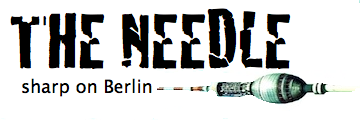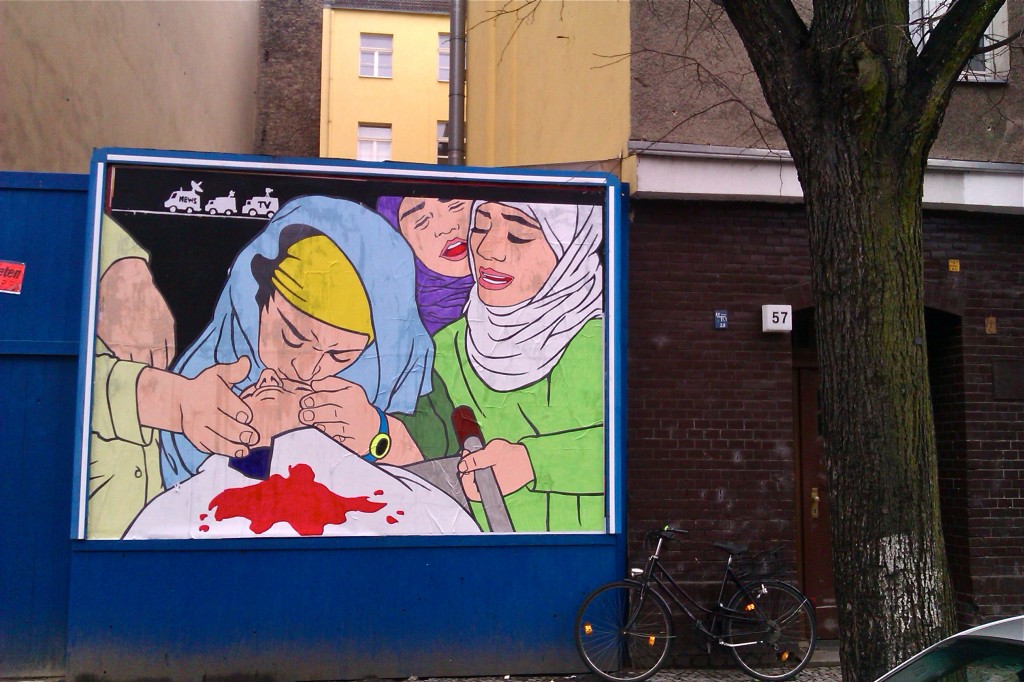The Arab Spring in Berlin
On Hobrechtstraße in Neukölln, that corner of Kreuzkölln between the Lebanese community on Sonnenallee and the canal, there is a new work of street art. It looks like a window cut into a wall. Through it we see people so far away that they appear caricatures. Heartbreaking events are reduced to a limited number of colours and etched cartoon figures. The TV cameras survey at safe distance.
I am no expert on the Middle East, but I have travelled the region, speak some Arabic, and made an extended stay in Syria. Even with this exposure, it is uncanny to think of familiar places gripped by crippling violence. I try to imagine places in Syria today, cities I know like Hama, and find the pictures on the internet render them wholly unfamiliar. Violent scenes online are always replaced by the more durable impressions of my actual visit there: conversations, dinners with local people, and the reigning, tense, peace in the streets. This sense of removal is of course enhanced by now being physically in Berlin, with its wealth, detachment and stability.
‘Arab Spring’ appears here as an ubiquitous buzz phrase, not just on Youtube or in the news, but also in art and photo exhibits, usually alongside references to Twitter or the universal presence of Facebook. ‘Arab Spring’ is used in claims of how electronic media connects all of us and makes worldwide revolution possible.
Meanwhile, I remember an image of crowds in Tahrir Square, clamouring around one television set for information, and think that while we have the wealth for the gear, the IPads, the Macbooks and the broadband, to consume the revolution, the popular base of the protest is decidedly low-tech.
So, where in Berlin can I get a better sense of how the protests that continue to sweep the Middle East, and their uncertain outcomes, are unfolding on the ground? I turned recently to the curation of film programs. Last month, during the Transmediale and Berlin Film Festival (the Berlinale), there was plenty of opportunity to meet filmmakers from the region.
But if I wanted to talk about revolution, Transmediale was a frustrating venue. The Egyptian curators of the Arab Shorts program had a point to make: they showed films that were only obliquely political, such as the disquieting images of Cairo’s Giza Zoo, by Solmaz Shahbazi. The 19th Century zoo is shown empty of visitors, creating a timelessness focusing on the natural environment, well removed from today’s civil strife. The curators in discussion later stated that, overloaded by the revolution, they purposefully put forward a program stripped of overt references to the struggle. They could neither handle it psychologically, living in Egypt, nor would they satisfy the demand that they be messengers providing an emotive testimony.
Fair enough. Let’s go elsewhere.
The Berlinale (the Berlin Film Festival), just a week later in February, claimed to be infused by the theme of ‘upheaval’, inspired by the Arab Spring, or so said the festival’s director. I thought: now, here, there will be an opportunity for greater discussion. But highly publicised films such as ‘Farewell My Queen‘ (about the French Revolution) or Angelina Jolie’s ‘In the Land of Blood and Honey‘ (about Bosnia) seemed forced into service of the buzz phrase. Eventually, I found actual filmmaking from Tahrir Square in lower profile, more informal, events. I attended one such panel discussion, of short films responding to the events in Egypt, called ‘Cairo: The City, the Images, the Archives’, moderated by Transmediale curator Marcel Schwierin. It did not shirk from showing video pieces from the protests themselves.
A presentation by the Mosireen Collective, an ongoing online video archive documenting police, army and government abuses during Egypt’s revolution, was graphically violent enough to reduce one of the Egyptian presenters to tears. She had to leave the room.
Is this what I came for? For my voyeurism to be satisfied? For an expression of ‘true emotion’? I was ashamed. The event only served to highlight the disconnect between the polished and corporate surroundings of Potsdamer Platz and events that remain distant. How to explain them when, as one presenter said, ‘they dominate our sleep’. She went on to recount a series of Cairo dreams invaded by family, protesters, blood, police, and Hosni Mubarak. After the presentation I spoke with another filmmaker who explained the difficulty of communicating the concentration of emotion and protest, to people who have not been there.
 The scenes online are affecting and our gestures of support meaningful. But if I think I am truly participating emotionally in the ‘online’ revolution through the medium of the internet, I’m mistaken. Shouldn’t we question our vicariousness more, or wonder whether the videos have the effect of creating emotional distance rather than proximity. Then there is the question of whether online participation substitutes real action. We may lend our voices of support, but I am made nervous by the idea that clicking ‘like’ after viewing a Mosireen video is enough, whether it simply allows us to feel political from a comfortable chair. And then there are people who simply wish to profit from the buzz words of Facebook protest. There are many things we can do for Egypt, for Syria. But really to do something requires much more than watching protest online and feigning participation.
The scenes online are affecting and our gestures of support meaningful. But if I think I am truly participating emotionally in the ‘online’ revolution through the medium of the internet, I’m mistaken. Shouldn’t we question our vicariousness more, or wonder whether the videos have the effect of creating emotional distance rather than proximity. Then there is the question of whether online participation substitutes real action. We may lend our voices of support, but I am made nervous by the idea that clicking ‘like’ after viewing a Mosireen video is enough, whether it simply allows us to feel political from a comfortable chair. And then there are people who simply wish to profit from the buzz words of Facebook protest. There are many things we can do for Egypt, for Syria. But really to do something requires much more than watching protest online and feigning participation.
I appreciate the way that I stumbled on the poster pictured above by surprise in a Neukölln street, that it is low-tech, that I do not know who the artist is. And I like how it suggests, in its purposeful style of the caricature, ours and the media’s, that we reconsider the Arab Spring’s emotional imprint, our physical and virtual connectedness to it: if we remain bystanders, if we do not write our politicians, if we don’t get out on the streets ourselves, if we are not there.


What intrigues me, is also who is the creator of this impressive piece. Especially as I have the feeling that many Arab residents of Berlin are not actively supporting the Revolution(s). I have seen mass demonstrations here against Israel, the US involvement in Iraq/Afghanistan, and similar matters. I have seen one demonstration supporting the Lybian revolution (and it was a very small one); and one supporting Assad (yes, supporting him, you’ve heard right), which wasn’t huge but it was surprisingly big given the issue (and had a bigger crowd than the one supporting the Lybian rebels). So is it an artist challenging the apathy of local Arabs amidst the horrors? Or is it only my interpretation given my observations? The original poster is a poster by Misereor (a Catholic welfare/foreign aid organisation), pointing out that even after the media attention has been gone elsewhere, there is still need for aid (and Misereor is there for the victims); in a way, the original poster also conveys some critique against Western media and people’s tendency to have a “cause de jour”.
Thanks for your perceptive thoughts: would you have a link to the original Misereor poster? (I searched on google images but couldn’t find it) The poster I refer to, I take it, references it? I am also surprised how apolitical the reaction has been: then again most of the Arab community in Berlin is Lebanese and Palestinian, and many refugees from the Lebanese war in the 80s. Syria can’t be their favourite neighbour, and Egypt probably feels a world away–just my hunch. If sectarian violence in Lebanon heats up on a wave of instability from Syria, then I would think we would see more reaction in Berlin. What do you think?
Pingback: #12/12 | neukoellner.net | Berlin-Neukölln